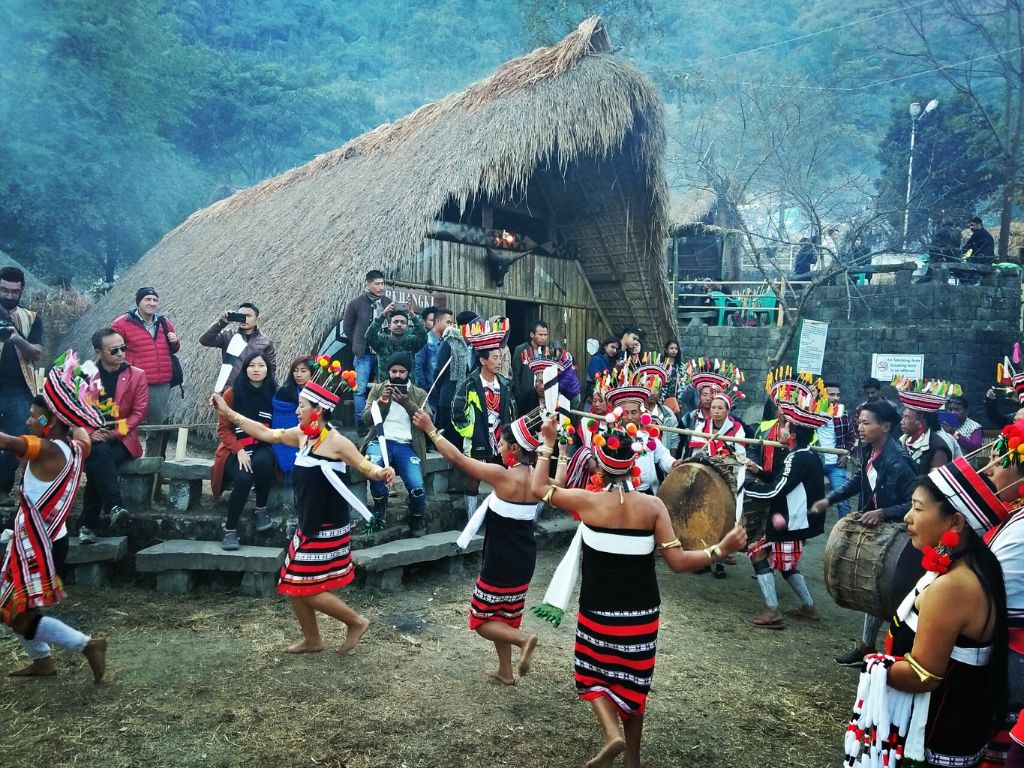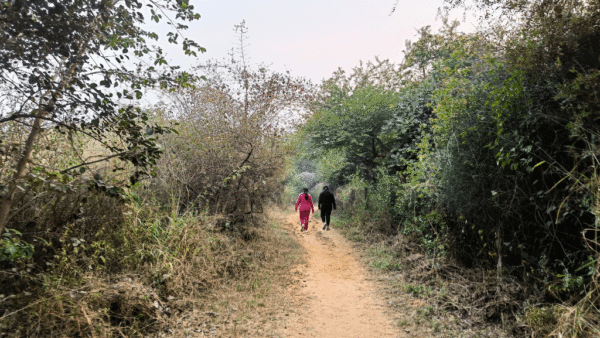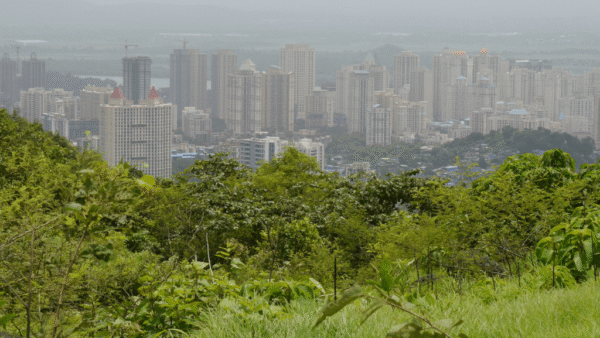The famous Hornbill Festival in Nagaland, held in the first half of December every year, ticks off the boxes. Clear blue skies, visitors absorbing the colour and food, people strolling around sipping local rice beer, posing for photos against the backdrop of Morung replicas, and watching tribal dances and music. Many domestic and international tourists have it on their calendar and the picturesque Kisama Heritage Village on their maps ever since the event, launched in 2000, became the window to the Northeast-bound.
The Hornbill Festival brings together various tribes of Nagaland to showcase and preserve their heritage and culture. Its name commemorates the bird which, in Naga folklore and tradition, is revered for boldness and grandeur. The Kisama Village complex was created as a cluster of 17 indigenously designed precincts or houses (Morungs), each representing a tribe of the state to give tourists a view of Naga tribes and their culture at one place.[1] It hosts performances, artists’ corners, exhibitions, games and archery, music fests, food and rituals of the state.[2] [3]
A major tourist draw, its 25th edition in December last year saw a total of 2,05,968 visitors though the majority were from the Northeast itself, according to the Department of Tourism in Nagaland.[4] This is nearly a 34 percent increase in a year. This edition generated around Rs 131 crore for the state.
While taking nothing away from the Hornbill Festival, a glimpse of the Naga way of life lies outside the Kisama Village too, in the real villages that are untouched by the grand Festival. These are vignettes of the typical Naga life – a woman solemnly crouching next to a grave, another rinsing her hair with leisure, strips of smoked pork and fish hanging from bamboo poles, jars of pickles fermenting in the soft sun. Would tourists want to ‘see’ this slice of real life, experience the Naga culture in the quiet and mundane rhythms of everyday activities, through the local communities?
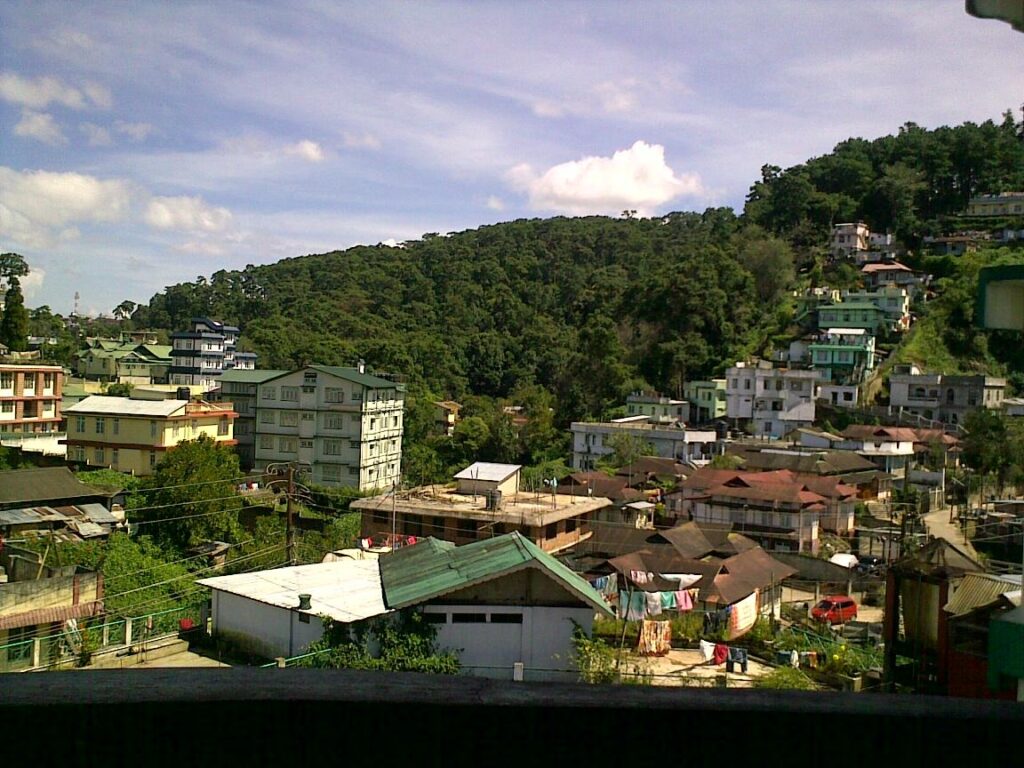
Photo: Wikimedia Commons
Community-based tourism
Beyond the curated experience that festivals and carnivals offer, however magical and successful they may be, there is scope for the other kind of visiting in which local people are involved in hosting visitors, opening up their daily rhythms as experiential tourism, and drawing benefit from it too. This is community-based tourism. It is a way for communities to reclaim agency and ownership in how tourism unfolds in their space and what impact it has on them and the environment. In Nagaland, Meghalaya, and Sikkim, community-based tourism happens alongside the grand festivals and tours.
Community-based tourism is described by the UN World Tourism Organisation as “tourism activities and services developed by local community members, working together in a club or group, sometimes in partnership with the private sector, based on special elements of local life, culture and nature which they feel proud and comfortable to share with visitors”.[5] The emphasis is not on extending luxurious hospitality to visitors but offering “a unique opportunity to meet local people, experience and learn about local culture, livelihoods and the natural world – directly from local people”.
A push for this came from the Asia Pacific Economic Cooperation (APEC) Tourism Charter endorsed in 2000 which recognised that community-based tourism could be a “vehicle for poverty reduction and dispersing economic benefits at the local level” besides diversifying the local economy, preserving culture, conserving the environment and providing educational opportunities.[7]
Community-based tourism can be more inclusive and sustainable than conventional tourism but, on the ground, it has been mostly done by NGOs and can be more complex too. Over the years, governments and corporates have begun to adopt the approach too.
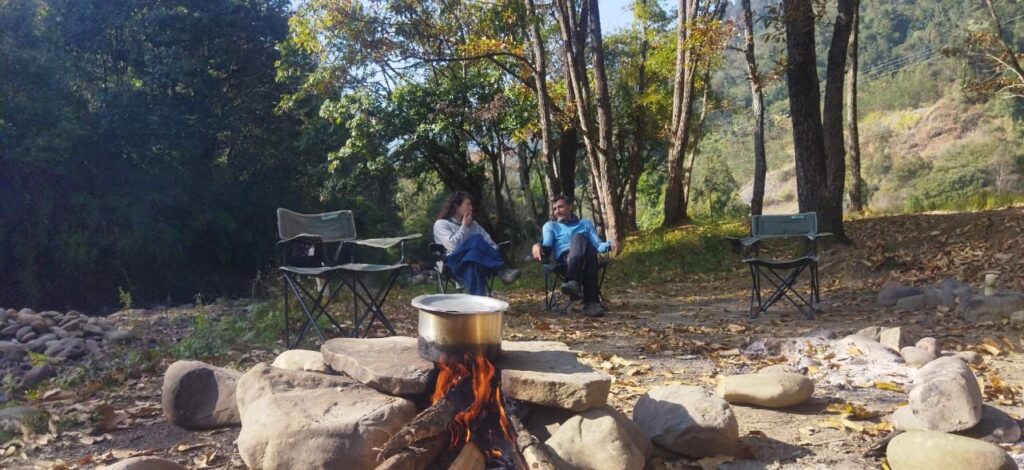
Photo: Atanu Buragohain
On the ground
Community-based tourism seeks to embed sustainability into tourism practice. Gerald Duia, founder of Duia Trailblazer in Meghalaya, starts with community-first planning. This means partnering with village cooperatives for food, locals working as guides, enlisting homestays and more by which the ecological impact of tourism is minimised. He holds site briefings for visitors and has developed an in-house training academy for guides to ensure that environmental and cultural sensitivity is maintained.
His organisation diverts tourist footfalls from overcrowded destinations like Sohra and Mawlynnong to lesser-known areas. “We don’t sell sightseeing. We offer the true Meghalaya experience,” says Duia. His takeaway is that not all tourists are conscious tourists. “There are tourists and there are travellers,” he explains, leaning on the latter. The community approach, he reflects, can be a roadmap of sustainable tourism. The involvement and participation of local communities in offering homestays, guided tours, dining experiences, cultural performances can be mutually fulfilling for tourists as well the locals.
“Communities usually don’t face major issues except when tourists come with disrespect or unrealistic expectations. Some tourists might hate the food or expect cuisines from the mainland, which affects the host’s morale. Locals enjoy sharing their culture and food when it’s appreciated. Why travel if not to experience something different,” asks Atanu Burgohain, a travel planner and tour operator.
In Sikkim, community-based tourism has, in small ways, intertwined ecological preservation with culture. Sanjoy Hazarika, the Northeast-based renowned researcher, journalist, author, filmmaker, and human rights advocate, says that homestays and community-led tourism began in Sikkim by the early 2000s. Prem Das Rai and others formed the Ecotourism and Conservation Society of Sikkim (ECOSS) and I was a part of some initiatives, Hazarika recalls. This model eventually spread to other Northeastern states.
Mostly, the homestays are in urban areas of Shillong, Kohima, Dimapur, not so deep in the villages, he adds. “About 20 years ago, there was a public discussion near Ward’s Lake, one of the few proper parks in Shillong and Chief Minister DD Lapang said that there’s a lot to be done for tourism in Meghalaya and we should take the Sikkim example which has involved common people in tourism and small businesses,” Hazarika says.
The Sikkim Development Foundation’s initiatives like the Kewzing Village HomeStay project has immersive authentic experiences for visitors while generating livelihoods for the local Bhutia communities.[8] As many as 1,200 homestays are spread across the state.[9] Sikkim has mandated environmentally sustainable measures for tourists such as garbage bags in vehicles.[10]

Photo: Wikimedia Commons
Can the environmental question be addressed?
A report by The Morung Express, a local best-selling newspaper, shows the environmental concerns around the Hornbill Festival. While it has placed Nagaland on the international tourism map and generated economic benefits, local voices have warned about environmental degradation, exploitation of locals, and government departments prioritising the needs of the tourists at the Festival over essential public services.[11]
The rapid rise in infrastructure projects has strained the fragile ecology in the region. Between 2013 and 2023, the Northeast lost a staggering 3,132 square kilometres of natural forest – an area larger than Mumbai – to road expansions, railway lines, and hydropower projects. During 2021-22, 14 new lines covering a total of 1,181 kilometres of the Northeastern Railways were launched.[12] In the past two decades alone, the total loss of forests equals three times the area of Delhi, according to this report.[13]
While new highway corridors such as NH-715A in Sikkim, four-laning of NH-27 in Assam and Arunachal Pradesh are needed to facilitate tourism, the ecological price has been paid by riparian habitats, avian species, and disrupted river flows.[14] The National Green Tribunal (NGT) weighed in, this February, on the construction of two five-star hotels next to the Kaziranga National Park and Tiger Reserve.[15]
Though the projects service many sectors, tourism rides on infrastructure expansion. Tourist arrivals have increased here. The number of domestic tourists rose from 3.13 million in 2003 to 95 million in 2019 – a Compounded Annual Growth Rate (CAGR) of 8 percent, according to this report.[16] With a report[17] in The New York Times listing Assam as the fourth must-visit destination in the world and this Travel Trends Report 2025[18] identifying Shillong as a popular destination, the pressure on the ecology rises.
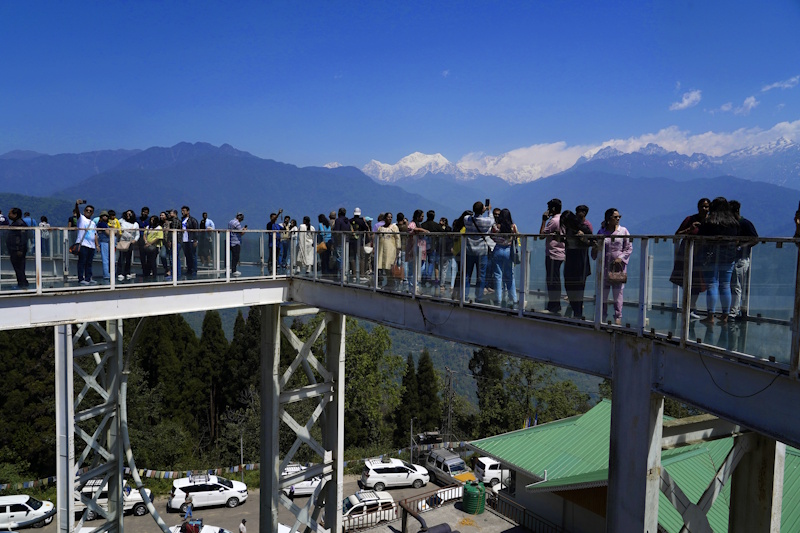
Photo: Wikimedia Commons
Community is sustainability
Organisations like Merak Tours, a Meghalaya-based tour agency, regularly organise training and awareness programmes for local communities on sustainability in tourism. “People have realised that tourism is a lasting source of income. We emphasise that before we offer hospitality to others, we must first respect our own customs and environment,” says Vanessa E. Sangma, proprietor of Merak Tours.
Sustainability is a mixed picture, says Tanka Dahal, a tour operator and founder of Sikkim Travels Hub. “Some people look only for money, some hosts think long-term”. He moved from a corporate job to tourist entrepreneurship. Tourism is a vital aspect of his life but he rues the visible environmental changes. Community-based tourism is an answer. However, it is easier spoken of than implemented.
In Sikkim, Nagaland, and Meghalaya, its idealistic portrayal gets challenged every day. Meghalaya’s Mawlynnong village, for example, has been celebrated as “Asia’s cleanest village” but handling nearly 250 visitors a day has stressed the community’s commitment to cleanliness and sustainability.[19] Community-based tourism, unfortunately, is also being used to brand experiences that conveniently mask commercial operations. “In ‘homestays’, it’s possible to find 20-room properties with hired staff, not families hosting guests,” says Laurige Boyer, co-founder of Eastern Routes, Meghalaya. Social media trends too bring tourists without genuine interest in the place or its people. “That’s a challenge for sustainability but we can’t afford to be choosy,” rues Burgohain.
Yet, if tourism has to genuinely empower local communities, maintain cultural integrity and environmental sustainability, there seem to be few alternatives to community-based tourism. Kevichülie Meyase, or KV, who owns Alder Tours and Travels in Nagaland, named his company after the Alder tree, called the farmer’s friend here because it enriches the soil and supports other trees. “I want my work to do the same for my community. My community is my tourism,” he says.
KV avoids the fast-paced commercialised approach. “There are homestays I haven’t promoted yet. Unless owners understand the meaning of community-based tourism, its ethics and responsibilities, I don’t want to,” he explains. He has been preparing communities through dialogue, training, and trust-building, by hiring locals as guides, supporting youth groups to showcase indigenous games and food, and so on. “The engagement has to be meaningful for all…Yes, tourism is good business but it must not come at the cost of our identity.”
There cannot be one model of tourism, as Hazarika says, “It has to depend on the environment of the village, capacity of the community, even the individual household.”
Many in the Northeast believe that the region is not ready for mass tourism and, if the rising trend continues, its famed trekking destinations may well become dumping grounds. However, communities and tour operators are becoming conscious of sustainability. Shillong is getting hotter and it’s the locals who feel the brunt of it, points out Boyer. When Cherrapunji and Mawsynram – among the wettest places on Earth – face drought-like conditions, the shift is serious for locals to rethink unregulated mass tourism. As KV eloquently says: “We must ask ourselves if we are being responsible with what we borrow from nature.”
Sugandhi Prapti, based in Guwahati, is a Sociology graduate from Lady Shri Ram College for Women with a minor in Journalism. She completed her Urban Fellows Programme from the Indian Institute for Human Settlements and her research interest lies on urban vulnerability, marginalized communities, and ecological challenges, particularly in Northeast India. The reporting for this essay was done as a part of her internship with Question of Cities.
Nikeita Saraf, a Thane-based architect and urban practitioner, works as illustrator and writer with Question of Cities. Through her academic years at School of Environment and Architecture, and later as Urban Fellow at the Indian Institute of Human Settlements, she tried to explore, in various forms, the web of relationships which create space and form the essence of storytelling. Her interests in storytelling and narrative mapping stem from how people map their worlds and she explores this through her everyday practice of illustrating and archiving
Cover Photo: Wikimedia Commons

